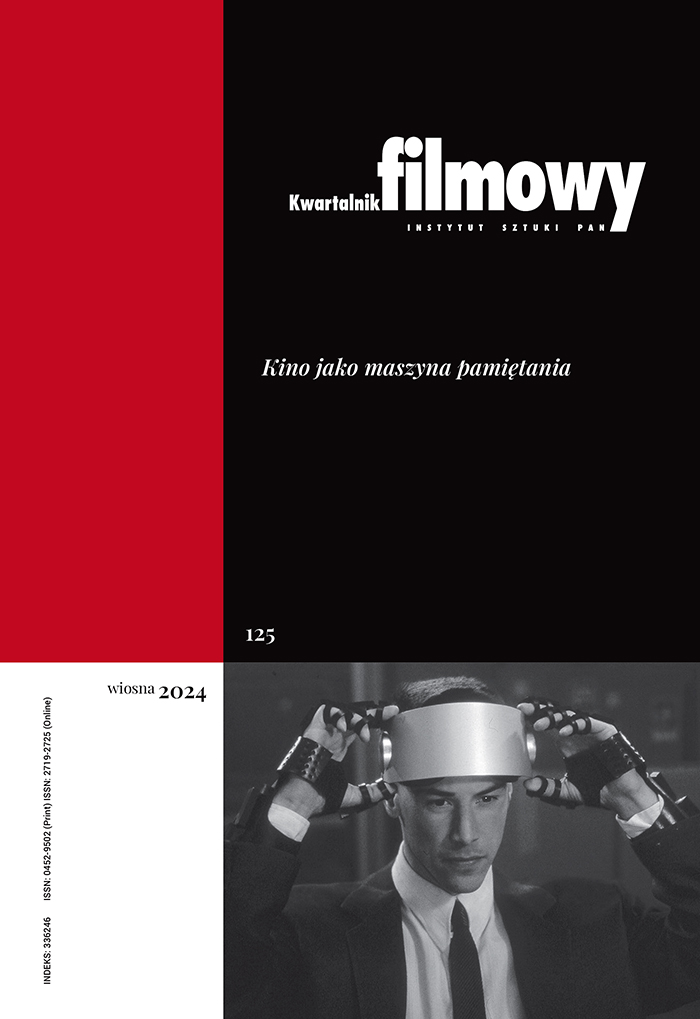Tarkovsky and Proust: “The Mirror” and “In Search of Lost Time” – “Something Else” but “One and the Same”
Abstract
Szymański considers in his essay what connects Marcel Proust’s In Search of Lost Time and Andrei Tarkovsky’s The Mirror, and what allows one to consider these masterpieces to be Deleuzian something else, and yet one and the same. The primary creative impulse for Proust and Tarkovsky was the need to tackle the problem of temporality and transience. They used memory and their works of art in order to recover the time lost. The act of remembering was not an end in itself – memories and impressions were supposed to aid discovering the truth about the world and “ego”. The result of the existential and artistic effort to recover the past was the discovery of true and timeless “ego” and the ability of its creative expression (where “remembering” also meant “creating”). The works of Proust and Tarkovsky, made authentic by the experience of their creators, are to be “a way of salvation”, and a “secular gospel” for readers and viewers.
Keywords:
Marcel Proust, Andrei Tarkovsky, Gilles DeleuzeReferences
Błoński, Jan. 1985. Widzieć jasno w zachwyceniu. Szkic literacki o twórczości Prousta. Kraków: Wydawnictwo Literackie.
Google Scholar
Czermińska, Małgorzata. 1983. Bohater autobiograficzny jako sobowtór (O wczesnej prozie Jarosława Iwaszkiewicza). W: A. Brodzka (red.). O twórczości Jarosława Iwaszkiewicza. Kraków: Wydawnictwo Literackie.
Google Scholar
Deleuze, Gilles. 2000. Proust i znaki. Tłum. M.P. Markowski. Gdańsk: Wydawnictwo słowo/obraz terytoria.
Google Scholar
Głowiński, Michał. 1973. Gry powieściowe. Szkice z teorii i historii form narracyjnych. Warszawa: Państwowe Wydawnictwo Naukowe.
Google Scholar
Iwaszkiewicz, Anna. 1987. Szkice i wspomnienia. Warszawa: Państwowy Instytut Wydawniczy.
Google Scholar
Kuśmierczyk, Seweryn. 2012. Księga filmów Andrieja Tarkowskiego. Warszawa: Wydawnictwo Skorpion.
Google Scholar
Markowski, Michał Paweł. 2000. Wahania języka. W: M.P. Markowski (oprac.). Marcel Proust. Pamięć i styl. Kraków: Wydawnictwo Znak.
Google Scholar
Maron, Marcin. 2011. Sytuacja autobiograficzna w „Zwierciadle” Andrieja Tarkowskiego. „Kwartalnik Filmowy” 33 (73).
Google Scholar
Poulet, Georges. 1970. Czas i przestrzeń Prousta: Czas. Tłum. J. Błoński. W: J. Błoński (red.). Proust w oczach krytyki światowej. Warszawa: Państwowy Instytut Wydawniczy.
Google Scholar
Tarkowski, Andriej. 1989. Kompleks Tołstoja. Myśli o życiu, sztuce i filmie. Tłum. S. Kuśmierczyk. Warszawa: Wydawnictwo Pelikan.
Google Scholar
Tarkowski, Andriej. 1991. Czas utrwalony. Tłum. S. Kuśmierczyk. Warszawa: Wydawnictwo Pelikan.
Google Scholar
Wachowski, Jacek. 1998. Kilka uwag o poznaniu somatycznym i aktorstwie. W: B. Judkowiak, E. Nowicka, B. Sienkiewicz (red.). Aktor w świecie i teatrze. Poznań: Abedik.
Google Scholar
Authors
Karol Szymańskikwartalnik.filmowy@ispan.pl
University of Gdańsk Poland
Absolwent historii na Katolickim Uniwersytecie Lubelskim i finansów na Uniwersytecie Gdańskim. Zawodowo związany przede wszystkim z trójmiejskimi wydawnictwami, drukarniami i agencjami reklamowymi jako redaktor i specjalista organizacji produkcji. Zajmuje się również refleksją o filmie i krytyką artystyczną; publikował artykuły w tomach zbiorowych (Spojrzenie – spektakl – wstyd, 2011; Kral Sumavy (1959): komunisticky thriller, 2014) oraz w „Kwartalniku Filmowym”, „Studiach Filmoznawczych”, „Biuletynie Historii Sztuki”, „Odrze”, „Ruchu Muzycznym”, „Więzi” i „Przeglądzie Papierniczym”. Pasjonat czechosłowackiej nowej fali i polskiej szkoły plakatu filmowego.
Statistics
Abstract views: 356PDF downloads: 267
License
Copyright (c) 2014 Karol Szymański

This work is licensed under a Creative Commons Attribution 4.0 International License.
The author grants the publisher a royalty-free non-exclusive licence (CC BY 4.0) to use the article in Kwartalnik Filmowy, retains full copyright, and agrees to identify the work as first having been published in Kwartalnik Filmowy should it be published or used again (download licence agreement). The journal is published under the CC BY 4.0 licence. By submitting an article, the author agrees to make it available under this licence.
In issues from 105-106 (2019) to 119 (2022) all articles were published under the CC BY-NC-ND 4.0 licence. During this period the authors granted a royalty-free non-exclusive licence (CC BY-ND 4.0) to use their article in „Kwartalnik Filmowy”, retained full copyright, and agreed to identify the work as first having been published in our journal should it be published or used again.
Most read articles by the same author(s)
- Karol Szymański, Mass and Community in the Rhythm of Steps: A Counter-Analysis of Soviet and Czechoslovak Societies in Ivan Balaďa’s Films “Metrum” and “The Forest” , Kwartalnik Filmowy: No. 123 (2023): Pace and Rhythm
- Grzegorz Piotrowski, Karol Szymański, Marilyn Monroe 1962 , Kwartalnik Filmowy: No. 83-84 (2013): Body in Film
- Grzegorz Piotrowski, Karol Szymański, Transnational and Therefore a Stranger? The Syndrome of Anna Prucnal’s Film Acting , Kwartalnik Filmowy: No. 95 (2016): Transnational Dimension of Polish Cinema
- Karol Szymański, The Rediscovery of Czechoslovak Film , Kwartalnik Filmowy: No. 75-76 (2011): Faces of Reality
- Karol Szymański, The Absent Present: Attempts to Returns to the Screen of the Duo Jiří Voskovec and Jan Werich After 1945 , Kwartalnik Filmowy: No. 97-98 (2017): Wandering Motifs
- Karol Szymański, Psychological Ballet in a Specific Configuration of Power: On the Polish Reception of the “Carriage to Vienna” by Karel Kachyňa , Kwartalnik Filmowy: No. 101-102 (2018): European Cinema of 21st Century











